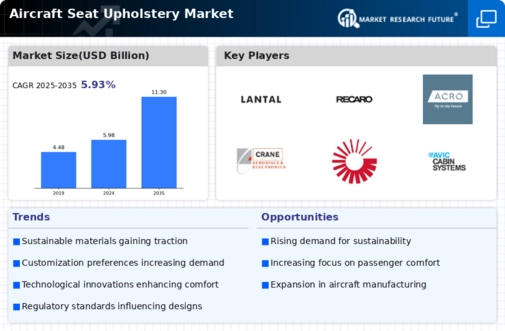Market Growth Projections
The Global Aircraft Seat Upholstery Market Industry is poised for substantial growth, with projections indicating a market size of 5.98 USD Billion in 2024 and an anticipated increase to 11.3 USD Billion by 2035. This growth trajectory suggests a compound annual growth rate (CAGR) of 5.93% from 2025 to 2035. Such figures reflect the increasing importance of passenger comfort, sustainability, and technological advancements in upholstery materials. As airlines continue to invest in enhancing the travel experience, the upholstery market is likely to evolve, presenting opportunities for innovation and expansion in the coming years.
Expansion of Low-Cost Carriers
The rise of low-cost carriers is significantly influencing the Global Aircraft Seat Upholstery Market Industry. These airlines often prioritize cost-effective solutions, including upholstery that balances affordability with passenger comfort. As low-cost carriers expand their fleets and routes, the demand for economical yet durable upholstery materials is likely to increase. This trend may lead to a diversification of upholstery options available in the market, catering to various consumer segments. The competitive pricing strategies employed by these airlines could potentially drive innovation in upholstery design, thereby impacting overall market dynamics and contributing to the anticipated CAGR of 5.93% from 2025 to 2035.
Growing Demand for Passenger Comfort
The Global Aircraft Seat Upholstery Market Industry experiences a notable increase in demand for enhanced passenger comfort. Airlines are increasingly investing in high-quality upholstery materials that provide better cushioning and support. This trend is driven by consumer preferences for more comfortable travel experiences, particularly on long-haul flights. As a result, the market is projected to reach 5.98 USD Billion in 2024, reflecting a growing emphasis on passenger satisfaction. Airlines are also exploring innovative materials that are lightweight yet durable, which could potentially improve fuel efficiency while enhancing comfort. This dual focus on comfort and efficiency is likely to shape the future of the upholstery market.
Sustainability Initiatives in Aviation
Sustainability is becoming a pivotal driver in the Global Aircraft Seat Upholstery Market Industry. Airlines are increasingly adopting eco-friendly materials for upholstery to align with global sustainability goals. This shift is not only a response to regulatory pressures but also a reflection of changing consumer preferences towards environmentally responsible travel. The use of recycled and biodegradable materials is gaining traction, which may lead to a competitive advantage for airlines that prioritize sustainability. As the market evolves, it is expected that sustainable upholstery solutions will play a crucial role in attracting environmentally conscious travelers, thereby influencing market dynamics significantly.
Regulatory Compliance and Safety Standards
Regulatory compliance plays a crucial role in shaping the Global Aircraft Seat Upholstery Market Industry. Airlines must adhere to stringent safety standards regarding materials used in upholstery, including fire resistance and durability. Compliance with these regulations not only ensures passenger safety but also influences material selection and design processes. As regulatory bodies continue to update safety guidelines, the upholstery market must adapt accordingly. This ongoing need for compliance may drive innovation and investment in high-quality materials that meet or exceed safety standards, thereby impacting market growth and positioning within the broader aviation industry.
Technological Advancements in Upholstery Materials
Technological innovations are transforming the Global Aircraft Seat Upholstery Market Industry, leading to the development of advanced materials that enhance durability and comfort. Innovations such as moisture-wicking fabrics, antimicrobial coatings, and fire-resistant materials are becoming increasingly prevalent. These advancements not only improve the passenger experience but also meet stringent safety regulations. As airlines seek to differentiate themselves in a competitive market, the adoption of these cutting-edge materials is likely to increase. The integration of technology in upholstery design may also contribute to the projected market growth, with expectations of reaching 11.3 USD Billion by 2035, indicating a robust trajectory for the industry.

















